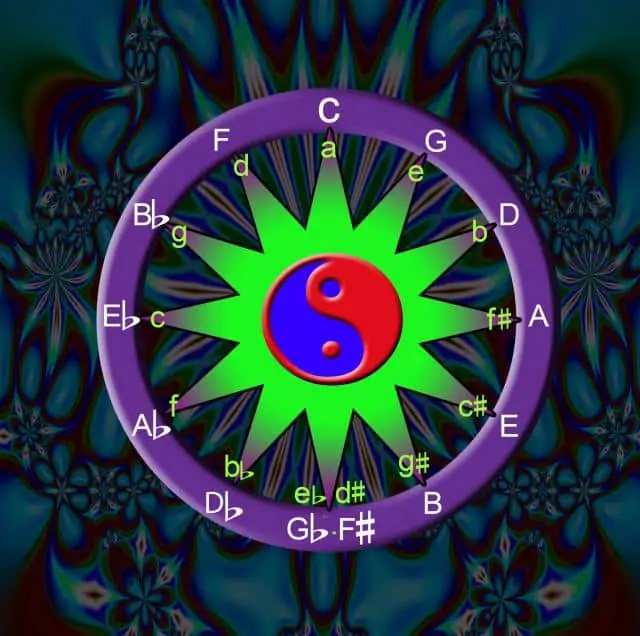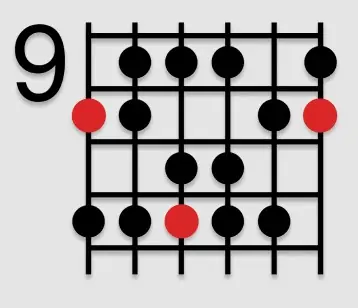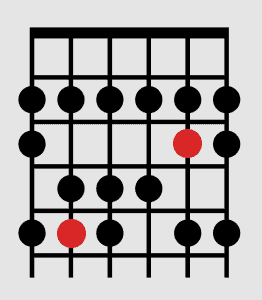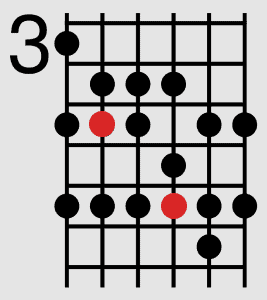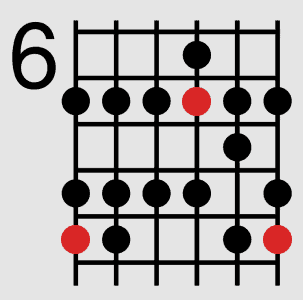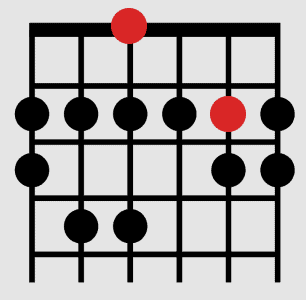Scales, it’s a word you’ll always hear in connection with improving your playing. But they can be so boring, especially when you’re running through them over and over and over.
You don’t need to torture yourself like that. Learn the D major scale, play it to warm up and improve your hearing, and then use it in all sorts of ways to get your fretting hand used to skipping notes and strings. After all, melodies are built out of scales.
If you just practice the scale up and down, you’ll gain speed and dexterity yes, but in a limited way.
So here is the D major scale and how to use it for left-hand awesomeness.
D Major Scale Theory
According to the circle of fifths, a very handy tool that you can use to see the sharps (♯) and flats (♭) in the key (and the key signature), D major has two sharps: F# and C#. I mention the sharps in this order because sharps (and flats) always follow the same order: F#, C#, G#, D#, A#, E#, B#.
Circle of fifths
In other words, the D major scale looks like this:
D, E, F#, G, A, B, C#
1 2 3 4 5 6 7
If remembering the sharps in the scale is difficult for you (for example, this is easy for me, but my husband prefers the pattern), you can memorize the pattern and always be able to know what any major scale is:
WWHWWWH.
The only thing you need to remember here is that between E and F and B and C, there are half steps. Between all the other notes, to get a half step up, you would need a sharp.
There you have a bit of theory for D major and then some. Next is to get to know your fretboard which is where playing your scales up and down really comes in handy.
D Major Scale Shapes
These fretboard diagrams have the root note (D) marked in red. It’s helpful in the beginning to say the notes, whether out loud or in your head which will help you to get to know the notes on the fretboard.
The scales may not always start on the root note, but rest assured that the notes are all in the D major scale. Most will span two octaves (an octave is 8 notes, in this case, D to D). If you find it easier, you can just practice from D to D, and leave the other notes that come before that out to really get a feel for the major scale.
Don’t leave your pinky out. You will find that if you designate each finger a fret, you will cross the fretboard more easily and smoothly. This is great for developing dexterity. For some scale shapes, you may need to shift
A helpful thing to know (if you didn’t) is that all except the last of these scale shapes are the CAGED system scales. All five shapes are moveable, as long as you know where the root notes are.
Also, all the CAGED scales can be linked so you can play across the whole fretboard as it suits your needs or creativity.
D Major Scale 1
D major scale 1
I chose to make this one first since it starts on the root note, not just because it’s position 1 in the CAGED system.. You’ll hear that it resolves nicely because if you play the scale correctly, by the time you get to that last D, it sounds like you made it home. The same goes for when you play it backward.
Most people shouldn’t have too much of an issue playing so far down the fretboard. The frets are smaller the further you go down although the neck does get wider. Most if not all guitars still have fairly easy access to the twelfth fret.
D Major Scale 2
Position 2 of the caged system is harder to play if you don’t have a cutaway guitar since you need to get down to the 15th fret. This shape is good for practicing how to shift if you have shorter fingers, otherwise, you can probably get away with playing it with each finger getting a designated fret.
D Major Scale 3
This shape is all the way at the top of the fretboard, so pretty easy to get to and familiar territory for beginners.
D Major Scale 4
As you can see, the first D is in the same place as with scale 3, but the shape differs in that the D in the 7th fret is used. Again, good practice for shifting.
D Major Scale 5
We’re back to using the root note in the 10th fret on the low E string.
D Major Scale 6
This is the open D major scale shape. As mentioned, it’s not part of the CAGED system. It’s still useful to know and you should be aware that it incorporates the use of the open D string. That string is represented by the red dot on the nut.
Fretting Hand Exercises
Doing these exercises regularly will help you to gain dexterity and speed. Don’t rush it. Start slow and work your way up. Use a metronome like Sound Brenner which you can download for free for Android or IOS. This will help you to play consistently and in time. Remember, you can play really fast, but if you aren’t consistent or in time with the music, you sound like you don’t really know what you’re doing.
Practice in Threes
This you can do across all the shapes. At points you will need to cross strings which will give your right hand some practice too. They can be finger twisters and mind twisters too, especially when you’re mentally tired. But regular practice will get your muscle memory going. I’ve tabulated these exercises to make it easier. If you need help reading tabs, click here.
Exercise 1
Exercise 1_1
Exercise 1_2
Exercise 2
This one goes past the second octave D to the E just to complete the sequence.
Exercise 2_1
Exercise 2_2
Exercise 3
Exercise 3_1
Exercise 3_2
Exercise 4
This one is my favorite, I just love the way it sounds.
Exercise 4_1
Exercise 4_2
Exercise 5
Exercise 5_1
Exercise 5_2
Exercise 6
Exercise 6_1
Exercise 6_2
Practice in Two’s
You can do this exercise with any of the scale shapes. It will help you learn how to skip notes fluidly. Be sure to practice this sequence backward and forward.
Practice in Twos
Arpeggios
Arpeggios sound beautiful and are pretty common in music. When you pick a chord in the intervals they are structured in, you get those nice 1-3-5 or 1-3-5-7 intervals. You can of course have arpeggios that use 9th chords, 11th chords, and so on, but for now, here are the initial two arpeggios mentioned using the scale shapes.
Arpeggio 1
This is just 1-3-5 for every chord.
Arpeggio 1
Arpeggio 2
This includes the seventh of each chord. It doesn’t go up a full two octaves just because we were going already on the 17th fret. If you have a cutaway guitar, feel free to shift up again and keep going.
For those with other guitar types, you can always do this up to where you can and be sure to practice the arpeggios in the 3rd, 4th, and 5th CAGED positions as well as open position. Everyone should practice across as much of the fretboard as possible anyway.
Arpeggio 2_1
Conclusion
There you have it. A few ways to use the scale for practice that will help your fretting hand to become awesome, plus some transferable skills for your picking or plucking hand.

Cheanné Lombard lives in the home of one of the new Seven World Wonders, Cape Town, South Africa. She can’t go a day without listening to or making music.
Her love of music started when her grandparents gave her a guitar. It was a smaller version of the full-sized guitars fit for her little hands. Later came a keyboard and a few years after that, a beautiful dreadnought guitar and a violin too. While she is self-taught when it comes to the guitar, she had piano lessons as a child and is now taking violin lessons as an adult.
She has been playing guitar for over 15 years and enjoys a good jam session with her husband, also an avid guitarist. In fact, the way he played those jazzy, bluesy numbers that kindled the fire in her punk rock heart. Now she explores a variety of genres and plays in the church worship group too and with whoever else is up for a jam session.
